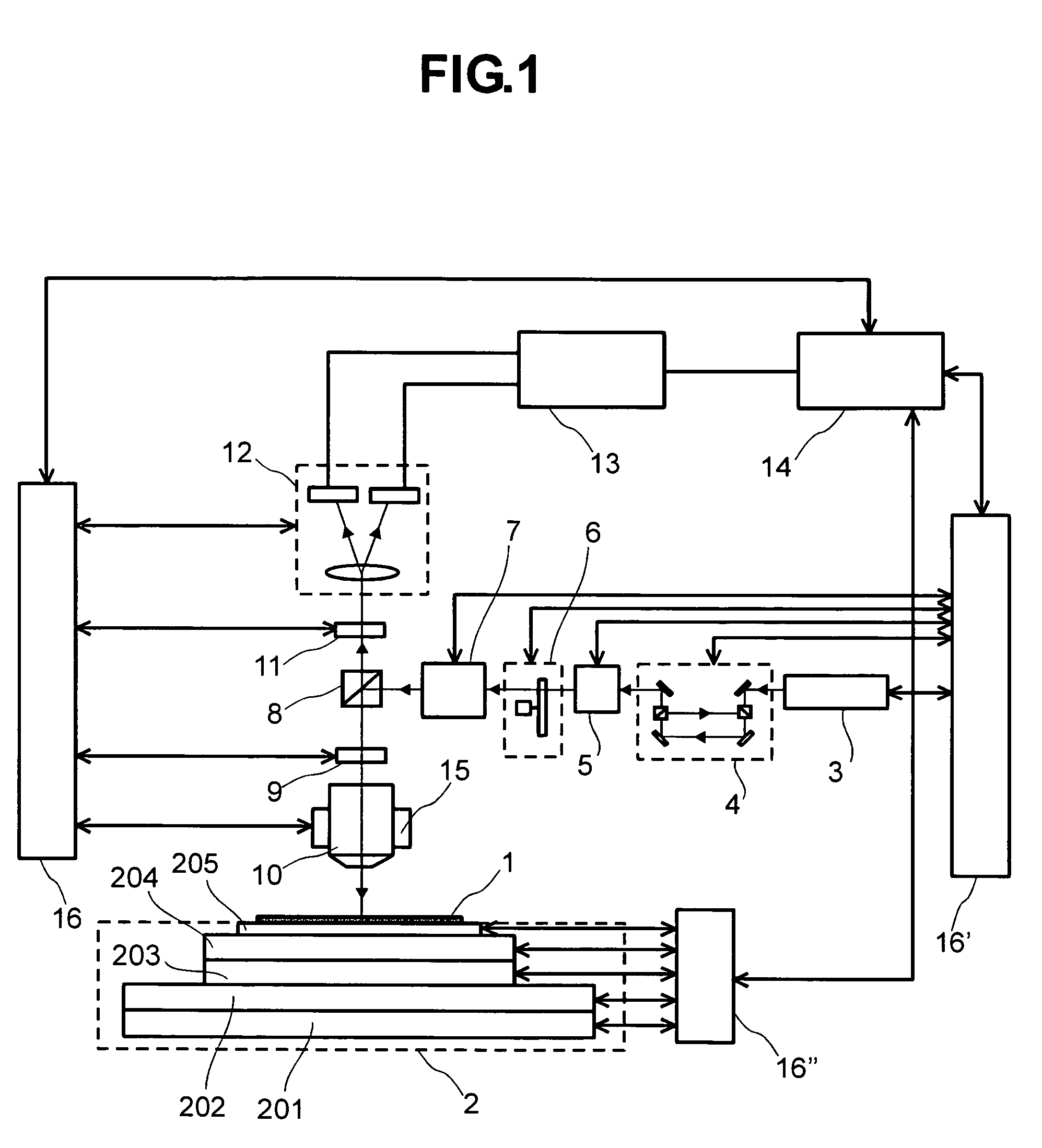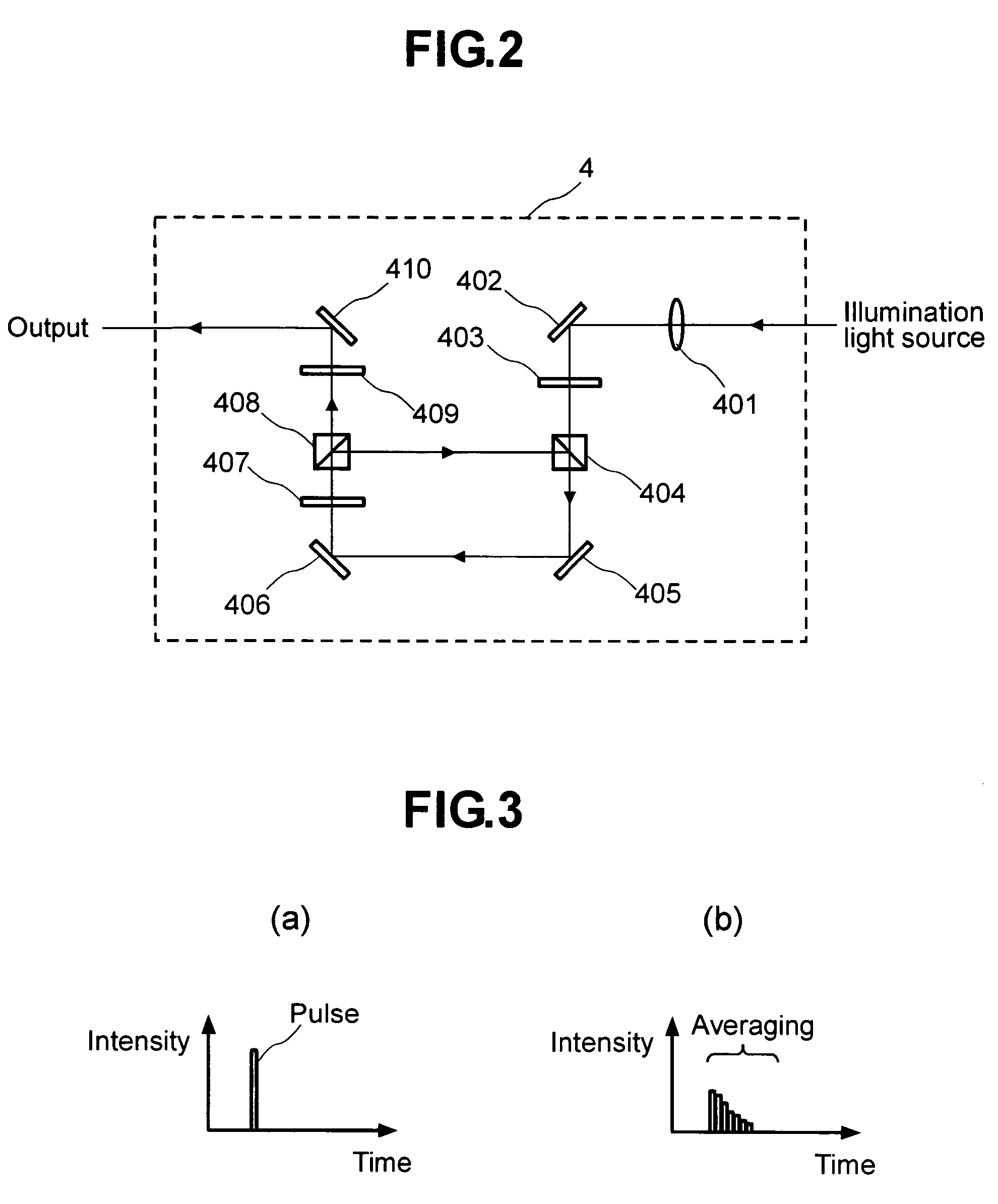Method and apparatus for detecting defects of a sample using a dark field signal and a bright field signal
a bright field and sample technology, applied in the field of sample defect inspection and foreign material inspection, can solve the problems of high peak power of lasers, difficult to detect by conventional technology, non-visual defects, etc., and achieve the effect of reducing the amount of light unevenness, and reducing the damage caused by illumination ligh
- Summary
- Abstract
- Description
- Claims
- Application Information
AI Technical Summary
Benefits of technology
Problems solved by technology
Method used
Image
Examples
embodiment 2
[0125]Another embodiment of a pattern-defect inspection apparatus according to this invention is shown in FIG. 26. The pattern-defect inspection apparatus of this embodiment consists of: the conveyance system 2 for placing and moving the wafer 1 to be inspected, the illumination light source 3, the pseudo continuous-wave forming optical system 4, the beam formation optical system 5, the coherence reduction optical system 6, the deformation illumination optical system 7, the PBS 8, the light modulation unit A 9, the objective lens 10, the light modulation unit B 11, the visual-field divided parallel detection unit 12, the signal processing circuit 13, the I / O unit 14, the A / F unit 15, a polarized-light dark-field illumination optical system A 18, a polarized-light dark-field illumination optical system B 19, and controllers, relay lenses, and mirrors of the units not shown in the figure.
[0126]Next, its operation will be described. The illumination light emitted from the illumination ...
embodiment 3
[0141]Another embodiment of the pattern-defect inspection apparatus according to this invention is shown in FIG. 34. The pattern-defect inspection apparatus of this embodiment consists of: the conveyance system 2 for placing and moving the wafer 1 to be inspected, the illumination light source 3, the pseudo continuous-wave forming optical system 4, the beam formation optical system 5, the coherence reduction optical system 6, the deformation illumination optical system 7, the PBS 8, the light modulation unit A 9, the objective lens 10, the light modulation unit B 11, the visual-field divided parallel detection unit 12, the signal processing circuit 13, the I / O unit 14, the A / F unit 15, an illumination light source 20 having a wavelength different from that of the illumination light source 3, a dichroic prism 21, and controllers, relay lenses, and mirrors of the units not shown in the figure.
[0142]Next, its operation will be described. The illumination light of a wavelength λ1 emitte...
embodiment 4
[0147]Another embodiment of the pattern-defect inspection apparatus according to this invention is shown in FIG. 36. The pattern-defect inspection apparatus of this embodiment is constructed with: an oil-immersion conveyance system 22 for moving the wafer 1 to be inspected that is placed thereon while being immersed in a medium 2213, the illumination light source 3, the pseudo continuous-wave forming optical system 4, the beam formation optical system 5, the coherence reduction optical system 6, the deformation illumination optical system 7, the PBS 8, the light modulation unit A 9, an objective lens 10′, the light modulation unit B 11, the visual-field divided parallel detection unit 12, the signal processing circuit 13, the I / O unit 14, and the A / F unit 15, as well as controllers, relay lenses, and mirrors of the units not shown in the figure. The objective lens 10′ differs from the objective lens 10 shown in FIG. 1 in that it has a sealed structure such that the medium 2213 does ...
PUM
| Property | Measurement | Unit |
|---|---|---|
| widths | aaaaa | aaaaa |
| wavelength | aaaaa | aaaaa |
| wavelength | aaaaa | aaaaa |
Abstract
Description
Claims
Application Information
 Login to View More
Login to View More - R&D
- Intellectual Property
- Life Sciences
- Materials
- Tech Scout
- Unparalleled Data Quality
- Higher Quality Content
- 60% Fewer Hallucinations
Browse by: Latest US Patents, China's latest patents, Technical Efficacy Thesaurus, Application Domain, Technology Topic, Popular Technical Reports.
© 2025 PatSnap. All rights reserved.Legal|Privacy policy|Modern Slavery Act Transparency Statement|Sitemap|About US| Contact US: help@patsnap.com



